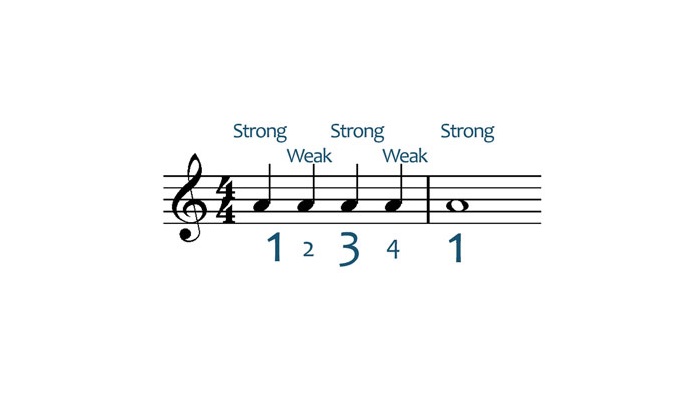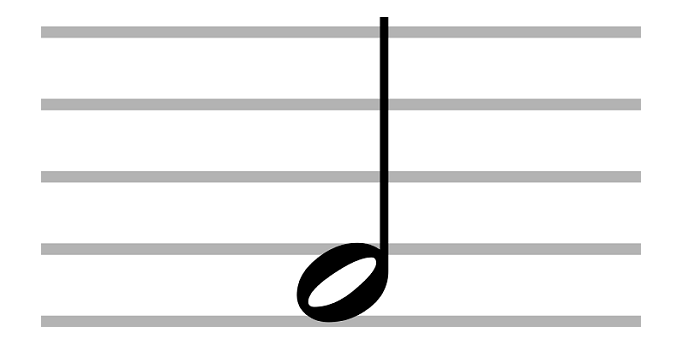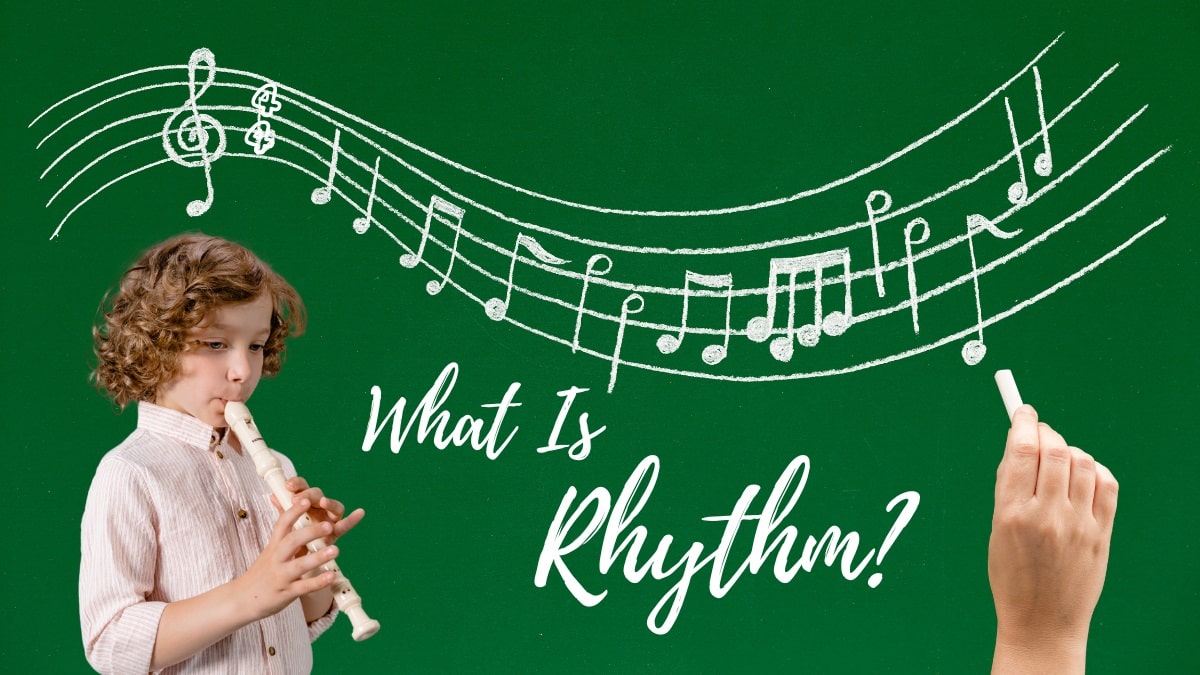Rhythm is one of the most complex musical concepts to define and explain. You hear songs every day in a wide array of different genres, but you probably wouldn’t be able to identify a rhythm if someone asks you.
Rhythm is the life of music; it connects everything. Think of an orchestra conductor keeping more than a hundred musicians playing in perfect harmony, regardless of each instrument’s tempo. Think of two drummers playing two contrasting beats and blending seamlessly. That’s all rhythm!
This article will discuss what rhythm is, its main elements, and the most common rhythms used in making music.
What Is Rhythm in Music?
A music’s rhythm is the way it’s divided into repeated beats of a specific number at a certain speed. In other words, it’s the controlled movement of the music, concerning time. We may define it in pulses, meters, or beats—in all cases, it’s how music is divided into regular metric portions.
It’s different from the music’s tempo, which is the speed at which the music plays. We’ll get into that later in detail.
You can also describe rhythm as the pulses pattern that results from strong and weak beats playing together.
When you listen to a song, and you want to move your body, clap your hands, or tap your feet along with it, it’s because you want to follow its rhythm, which consists of beats playing for specific time intervals.
What Are the Main Elements of Rhythm in Music?
The musical rhythm doesn’t work on its own. It depends on some factors and runs according to others. You’ll be surprised that it connects to nearly all musical elements.
There are many elements that make the rhythm, such as time signature, meter, accents, etc. Here’s a roundup of all of them.
Beats and Pulses

Beats are the primary measurement unit of music. When beats are repeated together, they create a pulse. All musical terms are connected somehow. A standard 4/4 time signature consists of four beats per measure. Each beat of the four lasts for a quarter a note, but we’ll get into these terms later.
If you still don’t understand, I’ll give you a simple example. When you listen to a song with a 4/4 time signature, and you feel the urge to clap your hands along. You’re feeling the pulses, and the act of clapping helps you match each beat.
The beats define the tempo, or the pace, of the music. It’s measured in beats per minute, famously known as BPM.
Time Signature
The time signature of any musical piece refers to the number of beats in one full measure and how long the beats last. It’s written as a fraction, such as 4/4, 6/8, 5/4, and so on. The two numbers indicate how you should count the rhythm.
The number on top counts the number of pulses in one bar, while the number on the bottom tells you what notes the pulses are measured in.
Time signatures that have the number ‘4’ for the bottom mean that the beat corresponds with a quarter note. For example, the time signature 5/4 means that a measure takes five beats to become whole.
Meanwhile, a 4/4 signature means that four beats are needed to make a full measure. It also means that each individual beat is the length of a quarter note.
4/4 is the standard time signature, but you may go beyond it. ¾ time signatures are meant for waltz music, and 2/4 time signatures are meant for march rhythms.
If the time signature has the number ‘8’ on the bottom, it means that the beat corresponds with an eighth note. That goes for ⅜, 6/8, 9/8, etc.
There are two common types of time signatures: simple and compound times.
Simple Time Signature

In simple time signatures, you can break the beat of the music into two-part rhythms. They’re pretty easy to count because one-two pulses typically sound the most natural to a listener’s ears.
Simple time signatures include 4/4, 2/4, ¾, ⅜, and 2/2.
Compound Time Signature
With compound time signatures, you break the beat down into three-part rhythms instead of two-part ones. With each beat broken into three components, you get a one-two-three pulse.
You’ll notice that all compound time signatures have the top number divisible by three. Common examples of them include 6/8, 9/4, and 12/8.
Tempo
Tempo is pretty easy to understand, contrary to most musical terms. It refers to the speed of the music. Tempo is mainly measured in beats per minute(BPM), but it may also be referred to in other methods.
Some people use the traditional Italian terminology to measure the tempo, and musicians these days mostly use the modern language.
Italian words like andante, allegro, largo, and presto have been used to convey the tempo for decades. They’re still used to this day in classical music.
As for the modern language, there’s nothing special about it. It refers to tempo in random words, such as slow, relaxed, fast, and moderate.
Strong/Weak Beats

If you want to make music, you’ll need a movement of strong and weak beats to happen. Beats aren’t all equal; you need a variety to make music happen.
Any musical rhythm is made of strong beats and weak beats. The strong beats are meant to drive the pulse. They incorporate the downbeats, which are the first beats of each measure. They also include some heavily accented and prominent beats.
As for the weak beats, they’re responsible for counteracting the pulse.
If you’ve heard the terms ‘downbeat’ and ‘upbeat’ before, let me make matters simple for you. There’s a pattern of weak and strong beats in all time signatures, and the first beat is slightly stronger than the others. That’s what we call the ‘downbeat.’ The upbeat, on the other hand, is the one right after the downbeat.
When you see a conductor move his hands according to the music being played, he’s actually moving them down for downbeats and up for upbeats.
Meter
If you’re a musician or have a passion for music, you probably know a bit about music theory. The theory divides all time signatures into three main types of meters: quadruple meter, triple meter, and duple meter.
The meter is the musicians’ way to subdivide the beats within a measure. Subsequently, you can divide any rhythmic pattern or any time signature into meters of two or three.
The beats come in groups of four in the quadruple meter, groups of three in the triple meter, and groups of two in the duple meter.
Unlike time signatures, meters aren’t related to note values. For example, a triple meter can have three-quarter notes, three half notes, three sixteenth notes, or three eighth notes. It can have three notes of any possible duration.
The duple and triple meters are commonly mixed in a technique approached by many musicians.
Accents

Accents are the emphasis we put on some beats to define the music. You may think they’re an insignificant musical element, but sometimes, they’re all that makes the difference.
Let me give you an example; If you have two musical rhythms that share the same tempo and time signature, wouldn’t they sound the same?
The answer is yes unless you put an accent on some beats. In that case, the rhythms will sound completely different, so accents are actually far more vital than what people know.
The pulses of any song focus on the accented beats; that’s why they make you want to tap your feet or move your head along. Some music genres play unaccented beats most of the time, so they don’t give the same feeling. A perfect example of that is reggae music.
Usually, musicians accent the first and the third beats and leave the rest unaccented. These are the strong and weak beats of a pattern.
Syncopation
Syncopation is a bit challenging to get a grasp of, so open your mind a bit with me.
In brief words, syncopation is putting emphasis on a note that wouldn’t have been emphasized otherwise, like the second eighth note in a 4/4 measure. In other words, it goes against the traditional time signature pattern.
In music pieces, the time signature indicates the recurrence of strong and weak beats in a pattern. On the other hand, syncopated rhythms emphasize the weak beats; that’s why they’re often described as offbeat rhythms.
In offbeat rhythms, the notes between strong and weak beats are prominent and accented.
All complex rhythms include syncopation. For instance, jazz music is typically syncopated with two and four notes of a 4/4 measure instead of the one and two notes. Meanwhile, reggae music utilizes an offbeat guitar that provides the distinct downstrokes of the music.
To play music in syncopation, you’ll have to count the off beats. For example, if we have a 4/4 measure, you’d count four beats. The spaces between them are the spaces between the weak and strong beats. Those define syncopation.
Polyrhythm

Like syncopations, polyrhythms are hard to get your heads around. But that’s the way it is with most musical terms, so I’m not complaining!
A polyrhythm happens when you play more than one different rhythm at the same time. When different rhythms are combined, they create a beat that’s more dynamic than the individual ones.
Polyrhythms are easily identifiable with drums, more so than other instruments. For example, if you play a couple of conga drums at a 4/4 time signature and play a timbale at a ⅜ time signature simultaneously, you get a polyrhythm.
Musicians can widely use polyrhythms to create danceable patterns, which is pretty expected, seeing as they originated in Africa from playing drums. Back in the day, polyrhythms were exclusive to African music, mainly drums.
However, the dynamic rhythms are now included in a wide array of genres, including jazz, contemporary classical, and progressive rock.
Odd Time
Odd time signatures can take some musical pieces to a whole other level. Some musicians build their careers on creating sounds out of unusual measures.
They create odd times by combining simple and compound times. On top of that, they mostly base their signatures on combinations of duple and triple meters.
For instance, if we have a ⅝ signature, it can be broken down to a triple group followed by a duple group or a duple group followed by a triple group. Subdividing the measures like this helps musicians create their odd time signatures, following the patterns based on these subdivisions.
Why Is It Important to Have a Good Rhythm?

Having a good rhythm isn’t only necessary. It’s vital for playing music, especially if you play in a band. It enables you to stay in harmony with your band. Additionally, once you understand it and study it well, you’ll be able to play any rhythmic figure after only hearing it.
Believe it or not, you’ll be able to sight-read the rhythm if you understand it well enough.
These previously mentioned skills are what make mediocre musicians different from professional ones. And you can only acquire them if you know how to create a good rhythm.
Think about what made the greatest bands of history famous. It’s not the tempo of their music or the genre they sing; it’s their rhythm. If you compare two completely different bands, like the Beatles and Nirvana, you’ll find that what they have in common is the excellent rhythms. Without it, they wouldn’t have been able to sync with their bandmates.
Even listeners with no musical background can catch on to rhythm problems. In the end, rhythm affects everything, such as the time signature and the tempo. It can make or break a song.
The Most Common Rhythmic Notations in Music
To further understand rhythms in music, I’ll show you the most common rhythms musicians use and how they’re drawn in notation.
Whole Notes
Rhythms that consist of whole notes are often called semibreves. A complete note is supposed to last for four beats, taking up a full measure. If you play a whole note, you’ll have to hold it for four beats, and the same goes for a whole rest.
In musical notation, a whole note looks like a football that’s hollow on the inside.
Half Notes

Half notes, otherwise called minims, are worth two counts. In other words, each note lasts for two beats. It’s half of a whole note, so it’s pretty evident from its name. In notations, half notes are drawn as the same football as the whole notes, but with a stem added above.
Quarter Notes
Each quarter note plays for only one beat, which is a quarter of a whole note. A quarter note would look the same as the half note on notation, but the hollow football would be complete.
Eighth Notes
Eighth notes are sometimes called quavers. Each eighth note lasts for half a beat. If you want to draw it in musical notation, draw a quarter note and add a flag to the stem’s tip.
Sixteenth Notes
Most musicians call sixteenth notes semiquavers since they’re half of the eighth notes. Each sixteenth note is played for a quarter of a beat.
It’s drawn on a notation like the eighth note but with two flags attached to the stem.
Dotted Eighth Note
A dotted eighth note is called a dotted quaver; it’s when you add a dot beside the eighth note’s notation. In terms of music, this means it lasts for three-quarters of a beat.
Rhythm vs. Tempo: What Is the Difference?

People often mix up rhythm and tempo, thinking they refer to the same thing. Only true musicians know the difference.
While both rhythm and tempo directly correlate to how fast the music is, each of them contributes individually. The tempo is the speed of the music piece, while the rhythm is how long each note takes. Both depend on time, but in different ways.
To help you understand further, imagine a car driving down a highway. The vehicle is moving at a specific speed, which refers to the tempo. The rhythm here refers to the distance between the things along the road’s side.
Simply put, it’s how long the car takes to pass from one stationary thing to another, so it doesn’t have to do anything with the vehicle’s speed. However, the speed directly affects it.
When the tempo of a musical piece changes and the rhythm stays put, the only thing that changes is that the music will play faster, but the beats and pulses remain the same.
Let’s say it’ll move from point A to B, and then from point B to C in double the time. When the tempo gets faster, the music will move along the beats faster, but it won’t change the fact that the time of B-to-C is two times that of A-to-B.
However, if the rhythm changes, the music will sound completely different.








2 comments
Can I have the author's name so I can give credit? I want to use this in my 5th Grade class to teach about rhythm's importance in music.
-Mr. LaCombe
Hello Mr LaCombe,
Thanks for your message! You can just mention “Steve from ProMusicianHub.com”.